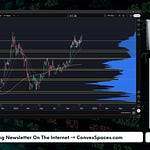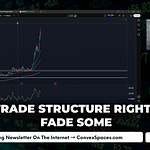What everyone is missing about the market.
If you’ve been doomscrolling through social media the last two weeks, you’ve probably seen endless chatter about deteriorating breadth, the Fed’s next move, and the end of the “Magnificent Seven” rally.
But the truth is, those narratives miss the real driver of modern markets: derivatives flow.
Once you understand how zero-DTE options, VIX futures, and skew positioning shape intraday liquidity, you’ll realize why the S&P 500 keeps defying gravity—and why breadth doesn’t matter anymore.
The New Market Structure: Derivatives Drive Everything
We’re no longer trading a “stock market.” We’re trading an options-driven liquidity machine.
Each of the top seven market-weight giants—Apple, Microsoft, Amazon, Google, Meta, Nvidia, and Tesla—has its own massive derivatives ecosystem.
When you add SPX zero-DTE options, the VIX complex, and hedging flows on top, you get a feedback system where liquidity = volatility control.
More liquidity → lower volatility
Lower volatility → tighter ranges
Tighter ranges → mechanical bids
That’s why it’s so hard for the market to roll over: the derivatives market is the market.
Why Breadth Doesn’t Matter Anymore
People still cling to the idea that 500 stocks drive the S&P 500. They don’t.
Seven names do—and their options flow dominates index price action.
When you see “breadth deterioration,” it’s usually just the byproduct of how volatility compression works.
Passive investors don’t care about Rigetti, Oklo, or micro-caps. They care about Google, Amazon, and Nvidia—and how those options trade.
Until those big-cap options break, the market structure itself prevents a real top.
The VIX Is Broken—And That’s Bullish
The VIX has been trading at a persistent premium to realized volatility for months.
Spot VIX near 17-18, January futures near 20. That’s insane.
Every time traders panic-buy hedges—VIX calls, long-dated S&P puts—those instruments decay, and that decay creates a synthetic bid under the S&P 500.
The irony: as long as investors fear a rug-pull, the rug can’t be pulled.
Until the VIX trades sub-15 for a sustained period, the market can’t meaningfully top. There’s simply too much hedging decay propping it up.
“Sell the News” Isn’t Selling — It’s a Mathematical Unwind
After Mag-7 earnings, China trade news, and the Fed decision, everyone screamed “sell the news.”
But the pullback wasn’t organic selling. It was a volatility unwind: upside risk priced into calls deflated once the events passed.
It’s the same mechanic that drove GameStop’s blow-off: when upside volatility expectations outpace what’s physically possible, the options premium collapses.
Result? A mild retracement that looks like “selling” but is really options math resolving itself.
Why Zero-DTE Options Keep the Market Pinned
Zero-days-to-expiration (0DTE) S&P options have transformed intraday behavior.
Every morning, trillions in notional exposure reset—providing intraday liquidity that keeps volatility compressed.
Unless something breaks that intraday feedback loop, big directional moves are almost impossible.
Every once in a while (Oct. 10, July 31) liquidity gets overwhelmed, we see a six-sigma down day, and then? Nothing.
No follow-through, because the structural liquidity comes right back the next day.
What’s Happening in Crypto and Why It Mirrors Equities
Crypto is the mirror image of equities.
Where SPX has compressed volatility through liquidity, crypto amplifies volatility through leverage.
Perpetual futures at 50× leverage create the same mechanical squeezes and unwinds—but faster and bloodier.
If you’re buying Bitcoin, you’re a derivatives trader whether you admit it or not.
What Traders Should Actually Do
Forget trying to call the top.
Instead, think in volatility regimes:
Trend vs. Reversion
High Vol vs. Low Vol
Right now we’re in low-volatility, range-bound reversion mode—what I call the Dog-Shit Trading Range (DSTR).
Buy dips, sell rips, harvest theta. The underlying drift is higher, but momentum is capped because the “good news” already got priced in through call buying.
If you want to be bullish, look for sectors that have fully reset—China tech, forgotten AI infrastructure names, anything with washed-out call interest and cheap convexity.
The Feedback Loops That Matter
You can visualize the market as an inverted bell curve of expectations.
Downside tail risk (via the VIX) is overpriced, and upside optionality (after earnings) is underpriced.
That imbalance fuels positive drift until the VIX collapses and upside gets expensive again.
It’s not about being “bullish” or “bearish.”
It’s about understanding where volatility is mispriced—and trading the feedback loops that follow.
When the Top Actually Happens
The market can’t meaningfully top until:
The VIX sustains under 15.
VIX futures normalize below 17–18.
Hedging demand dries up (no more “one foot out the door”).
Only then will downside sensitivity return and liquidity evaporate.
Until then, expect grind-ups, failed breakdowns, and relentless dip-buying.
Final Thoughts
Modern markets are a hall of mirrors—liquidity, volatility, and options positioning bouncing off each other until traders mistake noise for signal.
If you’re still analyzing “breadth” and “fundamentals,” you’re stuck in 2015.
The real game is happening in the derivatives complex—and once you see it, you can’t unsee it.









